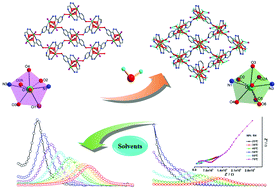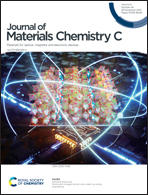Tuning the dynamic magnetic behaviour and proton conductivity via water-induced reversible single-crystal to single-crystal structural transformation†
Abstract
Employing external stimuli to manipulate the synergy between the magnetic behaviour and proton conductivity has stimulated extensive scientific interest due to potential applications in information storage, sensors, fuel cells, etc. Herein, we report the assembly of a unique dysprosium compound, {[DyL(Cl)(CH3OH)]·CH3CN}n(1) (H2L = N′-(5-fluoro-2-hydroxybenzylidene)pyrazine-N-oxide-carbohydrazide), which exhibits a humidity-induced reversible single-crystal to single-crystal transformation involving the cleavage and formation of multiple coordination bonds, generating a water-rich form of {[DyL(H2O)3]Cl}n (1′). Both phases are composed of layered structures based on {Dy2} dimeric units and extended by pyrazine-N-oxide groups of the ligand. In particular, the presence of water molecules not only changes the coordination environment of Dy3+ ions, but also releases a lattice chloride ion that alters hydrogen bonding between the layers, resulting in a synergetic switch of the dynamic magnetic behaviour and proton conductivity.



 Please wait while we load your content...
Please wait while we load your content...